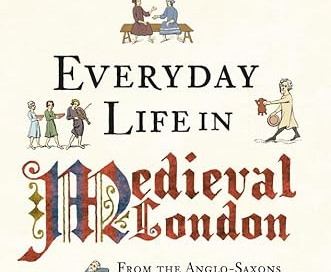Book Review: Everyday Life in Medieval London
From the Anglo-Saxons to the Tudors, by Toni Mount
Chaucer and Henries and Plague — Oh My!
Toni Mount has written a page-turner about London history from the departure of the Romans in AD 410 through Henry VIII’s Dissolution of the Monasteries in the 1530s and 40s. My favorite bit elucidates the origin of the House of Commons — from its imaginings in the Magna Carta of 1215 and its link with the building of Westminster Abbey, to its connection with Clerkenwell, the most interesting neighborhood in London (in my humble opinion).
Here’s the story: Famously, the disgruntled barons forced King John (formerly the evil Prince John of Robin Hood fame) to sign the Magna Carta, widely considered the world’s first Bill of Rights. It was actually a meaningless document since King John chose to ignore it, as did his son Henry III after him. Henry’s disrespect for the barons’ complaints primarily manifested itself in his profligate spending — of their money, that is. He levied high taxes on them to finance his rebuilding of the West Minster church of St. Paul’s (dating from the 1040s) into the Gothic Westminster Abbey that we know today. Wise to Henry’s medieval ideas of the divine right of kings to take all their money, the barons rebelled in 1264 in the aptly named Barons’ War.
The House of Commons’ origin story continues: Unwilling to abandon his renovation of Westminster Abbey — in which he hoped to be buried — Henry seized the treasure of the Knights Templar. King Henry may have thought that all property in England rightly belonged to him, but the merchants of London knew otherwise. The Knights Templar were their bankers, and the king had just stolen their property, stored in the Abbey as collateral. Not only had Henry offended the barons, now he had alienated the rich and powerful merchants of London. These commoners joined forces with the barons, led by Earl Simon de Montfort, and together, they defeated Henry at the Battle of Lewes (which you can remember, history buffs, because King Henry was the loser at Lewes).
Henry wasn’t dead, just foiled, and Earl Simon ruled in his place for a year or so before he was killed and King Henry resumed the throne. But while he ruled, Earl Simon made an unprecedented decision that affected English government to this day. He invited those common and rebellious merchants of London to join the barons at the Great Council (previously attended only by the nobility) to parler, as the French Normans would say — or to “talk” at Parliament. Thus began the House of Commons, born through a kleptomaniacal king ignoring the Magna Carta while building his Abbey and raiding the monks at Clerkenwell, thereby engaging the common merchants in politics. Henry was stuck with commoners advising him, but he got his way in the end: he is, indeed, buried near the high altar at Westminster Abbey, and you can visit him to this day.
Clerkenwell is the most interesting neighborhood in London, and Toni Mount writes about it beautifully. It was the first suburb outside London’s Roman walls (just to the northwest) and still has medieval treasures sprinkled throughout. Although Henry VIII dissolved the Abbey of St. John in 1540 (and though most of its buildings have been destroyed since), the pre-Dissolution gatehouse still stands in the middle of a modern street, connecting apartment buildings and businesses, with a museum inside. Nearby, the Abbey’s medicinal garden still flourishes, wafting relaxing fragrances over lunching workers on their breaks. And for those interested in hidden London, the original priory church crypt is underground and open for tours.
A few blocks south near the Smithfield Meat Market (where the slaughtering of animals and execution of criminals have taken place since Roman times) — just north of the ancient city boundary line — stand two of my most favorite sites in London: The Charterhouse and The Church of St. Bartholomew the Great.
The Charterhouse — a 17th century almshouse for the poor that still shelters pensioners! — was originally founded in the 14th century as a monastery to house monks praying for the souls of those buried nearby. An estimated 100,000 bodies lie in an emergency burial pit, purchased when the London churchyards could contain no more during the 1349 Great Pestilence. The exact location of the burial ground was lost to time, but local tradition held that the dead rested beneath Charterhouse Square, now surrounded by beautiful buildings on all sides. It was only in 2013 when engineers and archaeologists excavated tunnels and shafts for the new Elizabeth Line that suspicions were confirmed: the benches and oaks of Charterhouse Square stand over a plague burial pit. Archaeologists found the dead laid out in orderly rows, and DNA tests detected the bacteria Yersinia pestis, the cause of Bubonic Plague.
The magnificent Church of St. Bartholomew the Great predates even that disaster. Built in 1123, much of it still stands intact and is home to an active community of worshipers. The remaining structure has survived Henry VIII’s Dissolution of the Monasteries, the Great Fire of 1666, the zeppelin attacks of World War I, and the Blitzkrieg of World War II. Its proud congregants just celebrated the church’s 900th anniversary last year.
If these stories interest you, you will love Toni Mount’s well written account of so many more medieval stories.
All of this history in my favorite neighborhood has inspired me to begin research for a second novel. It will begin with an unsolved mystery during the 1349 Black Plague that will be resumed when the secrets of the dead are unearthed in 2013. Stay tuned!



